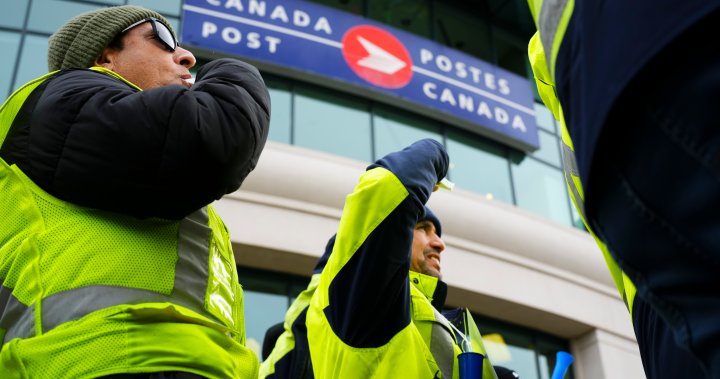Negotiations between Canada Post and the Canadian Union of Postal Workers (CUPW) continued as the strike inches closer to the holiday season.
Higher wages, better medical benefits and changes to the postal service’s use of temporary workers are at the heart of the union’s demands at the bargaining table.
Canada Post on Sunday said it provided the union with a “comprehensive framework for reaching negotiated agreements.”
“It is our hope that these proposals will reignite discussions and, together with the support of mediators, help the parties work toward final agreements. To facilitate talks, we will not be providing further details outside the negotiations process at this time,” a Canada Post statement said on Sunday.
CUPW national president Jan Sampson said in a statement that the union was reviewing the proposal.
“CUPW and Canada Post have both provided adjustments to demands to the special mediator in hopes that he will restart the mediation process. As of now the mediator has not informed us of a restart, but the Union is ready,” a statement from Sampson wrote.
Canada Post temporary workers
Jim Gallant, a negotiator for CUPW, told Global News that one of the key issues on the bargaining table is securing permanent jobs for Canada Post’s temporary workers.
“Over the past decades, Canada Post has moved from quite a full-time workforce to a more part-time and, even more concerning, temporary workforce. Some of these temporaries work as many as full-time hours and some more than that. The number is in the millions of hours,” he said.
Gallant said out of the 55,000 CUPW members, just over 22,000 are either temporary or part-time.
He said, “We’re not asking for an end to temporary work. There’s always going to be the odd day here and there that they need temporary employees and there’s a need for part-time employees. We understand that, too. But it can’t be the majority.”
Gallant said while older workers, those who spent 30 or more years working at the postal service, would be able to retire, younger postal workers have it harder.
“Young people are forced to work two and three jobs to make ends meet. If they could have one job that made it so they could support themselves and their family, they’d take it,” he said.
According to the federal government’s jobbank.gc.ca market report, the median hourly wage of a letter carrier in Canada is $28. In some provinces, the highest wage reached $38 per hour while in others, the lowest wage was $19 per hour.
Steven Tufts, an associate professor focusing on labour market research at York University, said Canada Post has seen competitive pressures over the last few years and is undergoing restructuring and change. Tufts said the heart of the dispute between the union and management is how to restructure and innovate without compromising on the rights of workers.
“There is an attempt to slowly tier the workforce. And that’s done by keeping things relatively the same for existing employees, but for all new employees or employees that don’t have full-time status yet, keeping them with a different set of benefits,” he said.
He added, “They want to increase the amount of part-time and temporary work. With the flexible scheduling that’s proposed, it would take forever for those part-time and temporary workers to get full benefits because they wouldn’t get enough hours in for years.”

Pay hike, better benefits
CUPW is also demanding a pay hike.
“We’ve put forward a 22-per cent raise over four years. And the employer has met us with 11.5 per cent,” Gallant said.

Get breaking National news
For news impacting Canada and around the world, sign up for breaking news alerts delivered directly to you when they happen.
According to the union’s demands, they are asking for an increase of nine per cent for the first year, five per cent in the second year, four per cent in year three and then again in year four. This would total to 22 per cent in five years, or 23.7 per cent compounded.
CUPW has said that wages have not kept pace with Canada Post’s non-labour expenses.
“According to their financial reports, from 2017 to 2023, non-labour spending increased by over one billion dollars per year, a 56.5% jump. During the same period, our wages only grew by 14.1%. Moreover, since May 2023 and continuing to at least May 2025, Canada Post has been exempt from contributing to our pensions,” Jan Simpson, CUPW national president, said in a statement in August this year.
The chair of Canada Post’s board warned in August that the organization’s financial situation is “unsustainable” as it struggles to compete against e-commerce platforms and faces dropping demand.
“The board and senior management recognize that Canada Post is at a critical juncture,” said André Hudon at the company’s annual general meeting.
“Significant change is urgently needed to preserve Canada Post’s delivery network, which is vital because it’s the only delivery network built to serve all Canadians.”
According to Statistics Canada, the country’s annual average inflation rate was 1.9 per cent in 2019, 0.7 per cent in 2020, 3.4 per cent in 2021, 6.8 per cent in 2022 and 3.9 per cent in 2023. As of October 2024, the inflation rate was at the Bank of Canada’s target rate of two per cent.
Tufts said Canada has been seeing a round of “catch up bargaining” between unions and employers, with wages stagnating over the pandemic and not keeping up with inflation.
Gallant said that workers are also demanding better health benefits.
“We haven’t had increases in things like dental or medical benefits in decades. And we’re looking for increases in those,” he said.
He added, “For instance, we’ve got a dental fee schedule that’s up to date. But the amount that we’re allowed to spend per year hasn’t gone up in decades.”
Tufts said better medical benefits are needed for a healthy Canada Post workforce.
“Being a postal worker, it’d be very hard on the body. Those letter carriers work very hard,” he said. “Sorting mail on your feet is very difficult. So having good benefits for postal workers is quite important given the nature of the work.”
Tufts said CUPW has also been at the forefront of resisting the shift from a defined benefits pension plan to a defined contribution plan.
“There’s a lot of pressure from employers on employees to switch pensions away from a pension plan that says you are definitely going to get this much when you retire to a program that says you’re going to get what dividends and how the stock market does and the pension fund does,” he said.
The union is also asking for a guaranteed 40-hour work week, maximizing and maintaining eight-hour routes, meal and rest periods, 10 paid medical days, a cost of living allowance and other benefits.
The Canadian Federation of Independent Businesses (CFIB) has estimated that the Canada Post workers strike, which began on Nov. 15 as 55,000 workers walked off the job, has resulted in $765 million in losses.
“It’s not Grinch who is about to steal Christmas. It’s Ottawa sitting idly on the sidelines while small businesses are losing crucial revenue and sales due to circumstances outside of their control,” said Corinne Pohlmann, executive vice-president of advocacy at CFIB, adding that by Wednesday losses could total up to $1 billion.
The strike has come as Canadians prepare for the holidays, with Christmas just over three weeks away.
“We feel for every small business and every child that is putting their letter out to Santa and everybody else in between,” Gallant said, “We want to be back at work and we wanted to be back at work three weeks ago.”
While some business groups have called for Ottawa to intervene, Gallant said he hopes it doesn’t come to binding arbitration.
“We’re hoping that we get a negotiated collective agreement so there can be some sort of labour peace instead of us going to arbitration and that taking years to finish,” he said.
Tufts said it was important to have some historical perspective on this strike.
“Historically, this strike activity or the hours lost to strikes has been actually quite low compared to real periods of militancy in the labor market in the 1970s and early 1980s,” he said.
He added that despite calls for binding arbitration, that may not yield the best results for either party.
“In this case, I don’t think arbitration is to the advantage of postal workers, and I don’t think it’s to the advantage of even Canada Post. There are a lot of complex issues on how we deliver mail and parcels that have to be ironed out at the bargaining table. And an arbitrator doesn’t understand postal delivery. The best they usually do is just focus on wages and compensation,” he said.
The Canada Post strike poses a question on the future of Canada’s public institutions, he said, and how they can innovate without sacrificing well-paying, permanent jobs.
“This is about our public institutions and we have to ask ourselves what kind of post office do we want? What kind of things can the post office do for us, whether it be postal banking or senior check ins that really provide benefits for for people and keep this institution secure for the future?”





